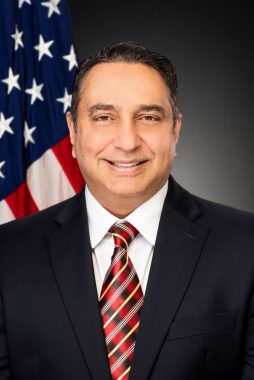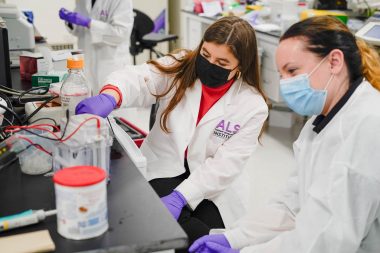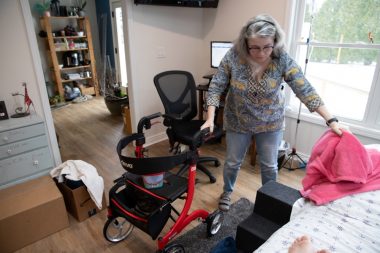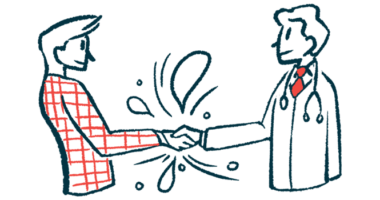Big Data a Source of Better ALS Insights, Trials, and Hope
Value in studying points that unite and distinguish patients with rare diseases

Healthcare has long harnessed the power of big data.
Examples range from the Human Genome Project, a worldwide 13-year effort to map DNA, to the adoption of electronic medical records— allowing doctors to quickly access patient information at points of care — and the rise of personalized medicine, which tailors treatments to an individual based on data collected about traits like a person’s genetic makeup.
Increasingly, big data now is making inroads into rare disease research. Numerous databases — run by academic institutions and nonprofits, healthcare groups, and governments — have come online to address rare diseases like amyotrophic lateral sclerosis (ALS), estimated to affect between 18,000 and 32,000 people in the U.S.
These databases collect large amounts of information on patients over time. Scientists use these data in studies into a condition’s origins and progression in hopes of shedding new light on both causes and prognoses. Such studies include natural history, or what happens if there is no treatment given, and analyses of blood biomarkers and changes in proteins and genes.
A shared big data goal: improving patient treatment and care, and designing better clinical trials needed to advance therapies.

Fernando Vieira, CEO and chief scientific officer of the ALS Therapy Development Institute, at right, and researcher Alan Premasiri analyze accelerometer data collected on ALS patients. (Courtesy of ALS TDI)
Among the larger of these efforts in ALS are the Pooled Resource Open-Access ALS Clinical Trials (PRO-ACT) database, the Precision Medicine Program from the ALS Therapy Development Institute (ALS TDI), and the National ALS Registry from the Centers for Disease Control and Prevention (CDC).
Along with others, these three pair data points tracking patients’ progression with information collected on their genetics, family history, medical and lab exam results, overall health, lifestyle, and environment.
The aim is to help explain why some people develop ALS, how it might be prevented, and how to better treat it.
“To have the more profound effects that we hope for clinically, we’ll need to have a better understanding of the underlying biology: whether or not there are subsets of ALS, who may have what areas of biology engaged, and whether that changes over time during the disease,” Fernando Vieira, MD, CEO and chief science officer of ALS TDI, said in an interview with ALS News Today.

Avi Kremer with his daughter Ella, 6. (Courtesy of Avi Kremer)
There’s a lot to be learned, Avi Kremer, co-founder of Prize4Life, which helped create PRO-ACT, said in an email interview. Prize4Life is now part of the ALS Association.
“Why did Lou Gehrig progress so fast and Stephen Hawking so slowly?” Kremer asked. “What do the ‘Stephen Hawkings’ have in common?”
Kremer points to natural history studies, which look at disease progression in the absence of an effective treatment, as essential in planning good clinical trials.
“It enables us to understand how the disease changes over time and this way learn … [how a treatment] can change the course of the disease,” said Kremer, 47, who can no longer speak due to ALS.
“The best thing for a clinical trial is for it to be short and decisive — to get the effective drugs to patients and the ineffective drugs out of the way to not take away resources. Natural history data and disease progression biomarkers are the drivers of that,” he said.
PRO-ACT, recognized in 2021 for its work in ALS research, has collected more than 11,000 de-identified patient records from 23 clinical trials, with both treatment and placebo trial arms. Its data also cover disability progression scores as measured by the ALS Functional Rating Scale-Revised (ALSFRS-R), use of ALS medications and their side effects, lung function, and muscle strength test results.
What do databases collect, and protect?
Patient databases combine a person’s disease history, collected through questionnaires or surveys, with information about the individual’s work, residency, and lifestyle, which may suggest risk factors. They also collect information on clinical measurements, such as ALSFRS-R scores and tests of breathing and muscle strength.
These data are protected in the U.S. under the Health Insurance Portability and Accountability Act (HIPAA) of 1996. Personal identifying information available to researchers is strictly limited and protected by safeguards.
What registries and databases collect often varies. Smaller ALS registries, like that of Massachusetts, mostly count ALS cases in given areas. Larger ones, like the PRO-ACT database and the National ALS Registry, tally cases and collect disease-relevant data, as well as demographics like a patient’s age, sex, place of residency, and work history, all of which could potentially establish risk factors. These larger collections also keep a repository of patient biospecimens for research.

Paul Mehta runs the National ALS Registry, which has collected over 100,000 survey responses from people with ALS. (Courtesy of Paul Mehta)
The National ALS Registry’s biorepository has collected biospecimens — including blood and urine samples, brain and nervous system tissue, cerebrospinal fluid, and other tissue samples — from 1,469 participants. A recent collaboration with the ALS Postmortem Tissue Core, started in 2013 by Lyle Ostrow, MD, PhD, has expanded access to patient tissues and data.
Fluid samples can determine levels of ALS biomarkers like oxidative stress, while tissue samples can peer into changes marking this disease, including mutations in genes like C9ORF72 or SOD1.
About 300 of these samples went through whole genome sequencing, said Paul Mehta, MD, a medical epidemiologist and principal investigator of the National ALS Registry.
“Their data is very, very valuable,” Mehta said. “If you can figure out what the risk factors are, you could potentially prevent ALS.”
The registry’s collaboration with the Johns Hopkins ALS Postmortem Tissue Core, directed by Ostrow, began in 2021; these efforts are in the process of moving to Temple University. At the National ALS Registry’s 2022 annual symposium, Ostrow presented results from a detailed survey of ALS researchers’ biosamples and data needs. “Our transition to Temple University and continued partnership with the National ALS Registry is enabling us to harmonize and integrate additional tissue and data resources, to best meet the evolving needs of ALS researchers,” he said.
To date, national registry samples have been shared with scientists at at least 22 sites — mostly universities, but also laboratories and pharmaceutical companies.
“There’s no end to the utility of having access to tissues because you can look at anything from exposures to genetics to pathology. And if you have frozen tissues … you can even culture cells,” said Elijah Stommel, MD, PhD, a neurologist with Dartmouth Hitchcock Medical Center in New Hampshire who’s approved to use registry fingernail samples in his research into environmental pollutants and ALS.
Big data and ALS: Promises and challenges
Potential for better trials, faster treatments
Big data is helping clinical trials become more efficient, aiding physicians in detecting signs of disease earlier, and assisting scientists in moving therapy discoveries from the lab into the clinic, known as translational science.
Amylyx Pharmaceuticals, which markets Relyvrio (sodium phenylbutyrate and taurursodiol), a newly approved ALS treatment, recently gave PRO-ACT data from the placebo arm of its CENTAUR Phase 2 trial (NCT03127514).
PRO-ACT also helped Amylyx. Patient information in the database was valuable in CENTAUR’s design, allowing researchers to define enrollment criteria — that marking fast disease progression — using models drawn from those data, said Sabrina Paganoni, MD, co-director of the Neurological Clinical Research Institute at Massachusetts General Hospital and the trial’s principal investigator.
The result was a smaller, quicker, and ultimately successful study.
“We knew that [patient group] was predicted to progress at a relatively homogenous and fast pace. So we targeted the population,” Paganoni said. “And we knew that we had enough statistical power to see a treatment effect, based on those simulations, with a trial of relatively modest size.”
Merged with artificial intelligence, data points on patients also improve the time to diagnosis, said Asaf Shiloni, CEO of the Israel-based company Kadimastem, which is developing a stem cell therapy called AstroRx. That therapy is expected to move into a clinical trial next year at sites that include centers in the U.S.
“I think that this is where a lot of the big data experts are looking at: how can we collect enough data that, if you connect a few dots from complaints from the patient, you can point to ALS earlier,” Shiloni said.
Such work could get a person into treatment at a time when there is still “a chance to hold the disease or to slow the disease … and to continue with something closer to a normal life,” Shiloni said.
Big data also is aiding translational science. According to the ALS TDI’s Vieira, the institute developed tegoprubart (then called AT-1501) partly through gene expression analyses of the SOD1 mouse ALS model that identified the CD40 ligand protein as a key target for the disease.
Analyses of patient blood samples also showed co-stimulatory pathway signaling, a regulator of immune system responses that acts via the CD40 ligand, to be overactive in 56% of ALS patients.
“When we modulated that pathway in the animal model with an antibody targeting CD 40 ligand … we decided, well, we need to now create a human antibody, this is a lead drug,” Vieira said.
Use of tegoprubart, a monoclonal antibody designed to block the CD40 ligand, was found to slow weight loss, delay paralysis, and extend survival in the mice.
Eledon Pharmaceuticals, which has since acquired tegoprubart, tested it in a Phase 2a trial (NCT04322149) in 54 ALS patients in the U.S. and Canada. Top-line results, announced by the company in May, showed safety and tolerability at ascending doses, a main trial goal, as well as lower levels of multiple pro-inflammatory biomarkers.

ALS TDI researchers collaborate on a project in the lab. (Photo courtesy of ALS TDI)
A larger trial is being planned, Vieira said, adding that this discovery underscores the need for much more data collection.
That’s one reason ALS TDI’s Precision Medicine Program — a translational research study launched in 2014 — is gathering data on ALS progression. PMP is tracking patients’ blood samples over time, along with ALSFRS-R scores, voice recordings, and movement captured through wearable accelerometers.
“Even the instances that we think are simple,” like discoveries using an ALS mouse model, “may not be,” Vieira said. “And it will take an immense amount of data, well beyond even what we have here — and we have a lot — to really tease these complexities out.”
Data collected via PRO-ACT and the CDC registry also are helping in tracking various clinical interventions — from respiratory devices to vaccines — that doctors are using with patients over time. That’s important, said Neil Thakur, PhD, chief mission officer of the ALS Association, because changes in care might be better, or equal, to currently approved ALS therapies.
Combining that information with specimens “gives us an opportunity to think about how to optimize clinical care,” Thakur said. “When do you do a specific kind of intervention? What kinds of services and support do we need to help prevent infections and falls and other kinds of complications of ALS that can shorten life and certainly makes the disease even more miserable than it is?”
The ALS Association is working to build a central data system to track disease complications to better spot and prevent them.
Concerns about overlap, data siloing, limited diversity
Data are collected on thousands of people every day and housed in many different, isolated databases. In data science, experts refer to this as data siloing, and it results in a lot of repeat data being gathered.
From the patient perspective, it can seem like there’s considerable overlap among institutions collecting information for databases or conducting clinical trials. Erin Dittoe, 55, who was diagnosed with ALS in November 2020, wears a watch that tracks her movements as part of a clinical trial (NCT05276349) that’s seeking to determine if at-home measurements can replace repeat visits to a clinic.
Dittoe has seen other similar studies on remote tracking.
“It’s difficult sometimes to differentiate who’s doing what,” Dittoe said. “Early on I tried to fill out as many questionnaires as I could and some of the details got lost. It would be nice if everyone was working together at the same time, instead of multiple people doing the same research at the same time.”

Erin Dittoe moving from her desk chair to her walker. (Photo by David Petkiewicz)
But different institutions collecting various types of ALS data and storing them in different ALS-related repositories is not necessarily a bad thing, Thakur said. He thinks streamlining silos could happen too quickly and go too far.
“It’s a judgment call. I think we can always spend more time on coordination and get some benefit, but you do start to get diminishing returns,” Thakur said. “And you get a layer of bureaucracy that may end up slowing things down if we over-coordinate and stifle creativity.”
Vieira agreed some parts of registries should be standardized, but said each institution should look at new ways to collect and analyze data gleaned from patients.
“If at the very least, we develop common denominator data sets, where each of the groups always captures ALS Functional Rating Scale, and always asks some surveys the same way, then we can relate the unique elements of each of our programs and start to tease apart what might be more useful and powerful,” Vieira said.
Collaborating on data and biospecimen collection was discussed at the National Institutes of Health (NIH) Strategic Plan Workshop in October. The two-day virtual event highlighted priorities that scientists, patients, clinicians, and advocates would like the NIH to pursue.
Discussion also touched on potential drawbacks to standardizing data.
“If you do everything the same way, you’re gonna all make the same mistakes,” said Thakur, who listened in to the meeting. “I think that’s a real feature of that conversation.”
For Thakur and the ALS Association, however, the priority is getting better care and treatments to patients.
“We’re focused on speed,” he said. “We want more clinical trials, we want to find new treatments and cures as quickly as possible.”
Big data, from registries to biospecimens and gene sequencing, are tools to help get there.
Another challenge is getting data from diverse patient groups.

Neil Thakur, chief mission officer of the ALS Association, favors speed in ALS research. (Photo courtesy of Neil Thakur)
Most data come from predominantly white patients in Western countries. Overall, this could be expected, because white people are generally more affected by ALS than minorities.
National ALS Registry data, current as of 2017, showed white people made up 73% of all its cases, Black people 6%, and the remaining 23% classified as other or unknown.
“It is challenging because some groups don’t want to join,” said Mehta, noting 100,000 surveys have been completed for the national registry. “There’s even a distrust for government in certain [groups] and geographical areas of the U.S.”
That’s partly a legacy of the Tuskegee study of the 1930s that left Black men with untreated syphilis after penicillin became available.
Still, Mehta’s confident of bringing more minority cases into patient counts, genomic data, and biorepositories. A CDC request to the U.S. Office of Management and Budget, if approved, would add data collected by health maintenance organizations (HMOs), other insurance companies, and nonprofits. These groups are likely to have more diverse — racially, ethnically, and geographically — patient populations contributing relevant information, he said.
What’s next?
Data about ALS is improving, thanks to awareness efforts and national research funding. Last year’s ACT for ALS Act, for instance, expanded the U.S. Food and Drug Administration’s treatment research program for this and similar diseases. Meanwhile, Congress earmarked $200 million for ALS research and programs for the 2022 fiscal year, which ran through Sept. 30.
But Dittoe, possibly like many ALS patients, says more federal support is needed, including for big data collection and analysis.
“Because the illness has been so underfunded, not a lot is known about it,” she said. “As more is learned about it, we’re going to see where it relates to other motor diseases as well as other brain diseases.”
That’s why Dittoe wants to share her data, especially as she’s “been fortunate in that I’m slowly progressing.”
“It’s doing my part,” she said of participating in the trial.
Many ALS patients are “very altruistic individuals,” Mehta said. “They want to help others, and they want to join the fight against ALS, when it comes to being part of the research.”
A credit analyst, Dittoe still works full time and occasionally uses her power wheelchair to get around. She’s taking Radicava (edaravone) to help slow disease progression.
Even understanding why Dittoe — like Hawking — is advancing less rapidly than that considered typical requires more time, more questions, more data, and more analysis, according to researchers. But at the bottom of all this could be a much-wanted breakthrough.
“We’re just not there yet,” Dittoe said. “It’s important to try to connect the dots where we can.”
This article is the first of a three-part series published as part of the Rare Disease Fellowship through the National Press Foundation. To read Part 2, go here. To read Part 3, go here.






